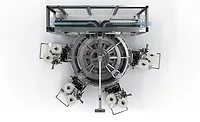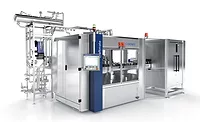Labeling equipment offer reliability while maximizing productivity
High speeds and accuracy crucial in beverage packaging and labeling equipment
The formulation has been carefully and meticulously perfected and packaged. And the next step is just as crucial to marketing the product and ensuring success of the brand — printing and applying labels.
Like a cog in a well-oiled machine, all facets of labeling equipment must work together seamlessly for optimal results. Packaging experts emphasize that a compact equipment design, a robust construction, a high throughput, up-to-date software, cost savings and fast consumable changes help maximize manufacturing productivity.
Raul Matos, vice president of sales and marketing for Miami-based Karlville, says today’s customers are looking for high efficiency and precision along with a total-solutions approach to their business. “We have machines with the capability to process up to twice the speed in half the space with high precision,” he says. “The machines let the client make and apply their labels as desired on the product. Above that, we have a unique understanding of the business as we are experts in both converting and packaging machines.
“As labels are fabricated on our converting machines, we ensure the label and application machines work in sync. In terms of expertise, our sweet spot has been high speed labeling at 400-700 bottles per minute (BPM) for beverage application as well as very high-end hot air solutions for nutraceutical applications,” Matos continues.
In the beverage industry, customers fall into two general categories: manufacturers and co-packers, according to Justin Slarks, director of marketing at Sleeve Seal, Little Rock, Ark. “Manufacturers want to run one to four different formats for days and days, while co-packers need versatile equipment that can be reformatted easily at a reasonable price,” he says.
He points out that large scale production is faster than it has ever been, benefiting manufacturers tasked with running high-speed lines and getting large quantities of beverages to store shelves quickly. “Typically large scale production is being done on dedicated product lines with a single product — or maybe several products packaged in a single container,” Slarks says. “However, all of the small companies or start-ups are looking to co-packers for packaging needs. The co-packers are busy [and] need to be able to change formats frequently.” Sleeve Seal services both types of customers with machines that run up to 1,200 containers per minute (CPM) and are versatile enough to allow for format changes, he adds.
Wood Dale, Ill.-based Videojet Technologies says its customers want equipment that delivers cost savings, longer uptimes and ease of use, along with quick ribbon and label changes that require little maintenance. Whether customers are labeling cases, skids or shrink wrap, David Freed, regional project manager of North America, believes the 9550 with Direct Apply is the solution.
“The 9550 places the label without the need for a tamp or blow box applicator while achieving throughput up to 150 packs per minute for typical four-inch by six-inch labels,” he says. “It is designed with automatic label and web tension detection and control to reduce set-up time and labor. Users can achieve label and ribbon changes in less than 60 seconds and a single, intuitive touchscreen interface stores label jobs on-board and allows for quick status checks and job selection.”
Freed adds that Intelligent Motion technology and the 9550’s direct drive system feeds and places labels accurately even at high line speeds.
As more converters enter the market for making shrink sleeves, Karlville’s Matos suggests that the most important aspect is lay flat (LF) specification, which must be determined by the machinery supplier.
“Once the LF has been met, the cut length (CL) must be agreed upon by a close collaboration between the end user, convert and machine supplier,” Matos says. “As new films are utilized, CL may vary from supplier to supplier as machine-oriented shrink may vary. It is critical to agree and come up with the best LF & CL specification prior to a Factory Acceptance Test (FAT) with grid and printed material.”
He also points out that although labeling inks have come a long way, it is critical to test with printed film during the FAT to assure a successful startup.
Experts stress that throughput, product shape and size, and label size are crucial to ensure a smooth labeling operation. Neal Oechsle, product manager for the M-series (print and apply labeling solutions), at Gurnee, Ill.-based Domino explains the three basic principles to applying labels — tamp-on, wipe-on and blow-on.
Tamp-on occurs when manufacturers have non-sensitive products and labels of different sizes, wipe-on is used for same-size labels and products, and the blow-on labeling approach works best for similar size labels and products with uneven or sensitive surface, Oechsle adds.
The fast blow-on principle is particularly effective with the uneven character of shrink-wrapped bottles, Oechsle says. “Our Dual Pad Labeling machine provides customers with a unique solution for printing and applying labels on shrink-wrapped bottles.”
Flexible packaging
With more beverage companies focusing on “going green,” recycling trends have resonated with beverage brands, printers and machinery suppliers, packaging experts say. They also note that although stiff packaging of cartons, cardboard cases and the like will not be completely eliminated, sustainability trends are driving packaging to be more flexible in nature like the standalone pouch.
Sleeve Seal’s Slarks says thin, recyclable films are answering a need. “Thinner films at nearly half the thickness of standard films now can do the same job and manufacturers are benefiting from fewer changeovers, lower shipping costs and are delivering a recyclable label to end users. Everyone is happy,” he says.
Karlville’s Matos says shrink sleeves present some challenges for recyclers because the label is difficult to separate in the caustic bath because of the density similarities of the bottle and label. To combat the problem, Matos is part of an Industry Consortium led by Eastman to scrutinize global solutions. “Today there are promising solutions such as specialty seaming solutions by Sun Chemical that disintegrate in caustic bath solutions for easy label removal to machinery that separate PET from PETG flakes with new technologies,” Matos notes. “The sustainability future for shrink sleeves looks bright.”
Future developments
Because many beverage manufacturers have streamlined their maintenance staffs, experts predict that labeling equipment will become simpler and less demanding — without sacrificing high speed. Domino’s Oechsle sees the future of labeling equipment to include multicolor solutions as well as developed machine-to-machine communications.
Noting their store appeal and com-munication prowess, shrink sleeves are great marketing tools, packaging experts say. Yet, labeling equipment must be adapted or developed to keep pace with demand for these beverage applications as well as new products with odd shapes, small- or large-sized footprints.
“As wrap-around labels are applied at high speeds, shrink sleeves need to follow same trend,” Karlville’s Matos says. “Our customers want machines that can provide various shapes within the same shrink-sleeve label format. We have found that our business model of high-speed machines with quick changeover features and low investment seem to outweigh being able to apply shrink and roll on labels.”
Videojet’s Freed says that increased retailer and regulatory requirements as well as SKU complexity will continue to present challenges for the industry. “Beverage manufacturers are seeking ways to safeguard their operations from costly labeling errors,” he says. He adds that the 9550 includes on-board job/message storage, automatic barcode creation, intuitive job selection and powerful diagnostics.
Experts also are seeing larger diameter applications for larger sized products.
“Even though, most machines are designed for beverage applications, we are starting larger diameter applications for the larger sized products,” Karlville’s Matos says. “One specific application is to cut out areas on the label utilizing lasers to provide space for product handling. We have a new partnership with LASX / Flexpack Services, a leading supplier of Laser System for Flexible Packaging Industry, for the development of such applications.”
Looking for a reprint of this article?
From high-res PDFs to custom plaques, order your copy today!





